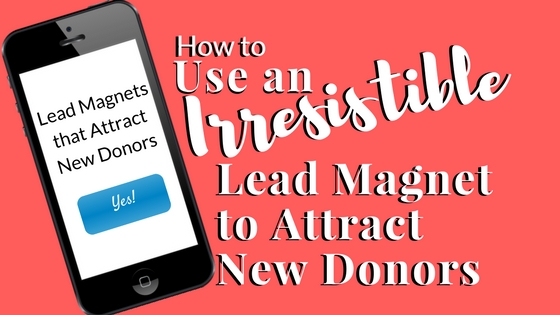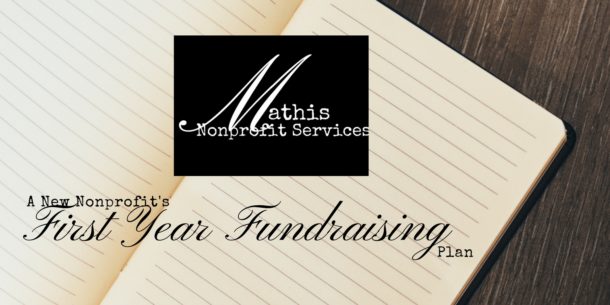Acquiring new donors is difficult but when you are not an established nonprofit, it seems to be an even harder task. It is disheartening for a new or small nonprofit to have put in the work to build the organization and find funding a struggle. One solution is free email marketing. But to do that, you need an email list. The first step in building a list is a lead magnet.
What is a Lead Magnet?
A lead magnet is a freebie that offers value to your donor in exchange for their contact information. Name and email address is often the easiest contact information to receive. The most common lead magnet for a nonprofit is the sign up for a mailing list or newsletter.
Why a Lead Magnet?
Lead magnets are a tried and true online marketing technique which build multi-million dollar businesses everyday. Adapting the technique to nonprofits becomes cheap donor acquisition. Consider that in the direct mail world, renting a list and mailing to a cold audience has a response rate of 1%. Of those 1%, only 19% will donate a second year. The cost of mailing and renting the list drives donor acquisition costs up. If you can save the list and mailing costs, you can dramatically lower your donor acquisition costs. Combine lower acquisition costs with the fact that online donors tend to give higher donations and you have a recipe for success. Research has also shown that it can be easier to persuade someone to give online. How can you ignore lead magnets with that kind of information?
Still not convinced? It also gives you a competitive advantage because so few organizations do lead magnets and email marketing well. Yes, just like in business you need a competitive advantage to compete for donors.
Why go beyond “join our mailing list” or “sign up for our newsletter”?
Nonprofits have used the “join our mailing list” for what seems like forever. Most nonprofits don’t follow through and actually send the email or newsletter. Over time, this erodes trust between the organization and the donor to the point that signing up or joining just doesn’t hold any value. At a time where a person’s personal information is so protected and valuable, not giving value and keeping promises is not a good business practice. For this reason, do not list build unless you commit to following through. Committing to list build, however, can be a game changer for your organization.
What do you need to build a lead magnet?
Building a lead magnet takes a website, an email service provider, a way to capture the contact information, access to something like dropbox or Drive to store and share a link to the lead magnet, an idea of what would be valuable to a new donor, and an email nurture sequence. Assuming you have gone through the 9 Action Steps Guide and already set up a website and an email service provider and you’ve decided on the link storage method, I will talk about ways to capture the contact information, ideas for what makes a good lead magnet, and an email nurture sequence.
Ways to Capture Contact Information
A landing page with a sign up form is optimal for lead conversions. Your email service provider (ESP) or your website should have this capability. If just your website has the capability, you will need to connect your sign up form to your ESP.
The landing page is a stand alone page someone clicks on to get more information or sign up. This page will spell out what the person is signing up for. It is where you will make your promises that you will be obligated to keep in exchange for the contact information. The one message you must convey is the big benefit or value of your lead magnet.
Once you new lead submits the form agreeing to sign up for your list, you will want to make sure your form is connected to your ESP and all the contact information is being transferred. You will also want to make sure your new lead has been segmented in your email list by source.
What Makes a Good Lead Magnet?
As you start to think about your lead magnet, you will want to make sure you are creating something of value to your potential lead. You will also want it to connect your mission and organization. You will want to make sure your lead magnet has the following characteristics to convert well:
- easily consumed – Lead magnets are simple documents that provide valuable information and should be easily consumed. You want your lead to use your lead magnet to build trust in the relationship.
- action-driven – Provide information that calls your lead to action. Give them something to do.
- creates noticeable improvement – Give your lead something they can do right now and can see results. This builds more trust.
- relevant – Your lead magnet is relevant to your potential lead. They won’t want it if it doesn’t apply to them today.
- instant – Your lead will get instant access to the lead magnet. This continues to build trust.
Email Nurture Sequence
You have your lead magnet created and set up. You’re done. Right? Nope. Remember when we talked about follow through? This step is where you have to follow through. Automating your nurture sequence will help you follow through and keep you consistent.
What is a nurture sequence? It is 3-5 emails that proceed the opt-in with the purpose of welcoming the lead, delivering more value, and setting expectations thereby building likability and trust. This sequence will also deter your leads from opting out quickly. Think of this sequence as a series of dates when determining what information to include. Here is the basic format a three email nurture sequence would follow:
- Email 1: Welcome Email
- Welcome your lead to your organization and in the first sentence or two provide a link to the lead magnet you promised.
- Introduce your nonprofit.
- DO NOT ask for a donation. (This is your first date. It’s creepy for your date to ask you for money). Instead, ask for one of the following:
- Click on a link
- Watch a video
- Listen to a podcast episode (if your nonprofit does this)
- Reply and answer a question
- Follow you on social media
- Tell your lead what to expect in and when to expect your next email.
- Email 2: Provide Additional Value (It’s your second date- build interest and desire).
- Provide something that enhances your lead magnet. Ideas are links to the additional reading material or other related materials.
- Share a success story of your organization.
- It’s still too soon to ask for a donation. Choose another ask from the bulleted list above.
- Email 3: Set Expectations (This is your third date. You are now entering into a non-mutually exclusive relationship and getting to know each other).
- Continue the lead magnet conversation (It’s what you have in common).
- Set expectations. What happens now?
- Tell them this is the last email on your lead magnet subject.
- Tell them they will begin getting emails with your newsletter and what the frequency will be. (Yes, you have to have a one-page newsletter now).
- If it makes sense at this time, ask for a $25 donation in the P.S. If not, use the ask list above to choose an option.
If you decide a five email nurture sequence makes sense to you, emails 3 and 4 will continue to add value to your lead magnet and you will still not ask for a donation until the last email.
There you have a lead magnet set up to gain new donors. If you are a member of the Facebook group At the Top: Small Nonprofit Leaders, Ideas for Lead Magnets that Convert will be available only to you. The idea sheet has a list of general lead magnet ideas and I took a look at the members of the group and put together a few ideas specific to your causes. It is my gift to you for being in the group!
If you aren’t a member of At the Top: Small Nonprofit Leaders, you can join here and get the Idea Sheet.
More resources:
The Ultimate Guide to Landing Pages by LeadPages


 Most nonprofit leaders lay awake at night trying to figure out how to fund their mission.
Hi! I'm Alesha.
I teach sustainable fundraising in a way that they can take action today so they can serve their clients.
I can help you move from just getting started funding your new nonprofit to gaining confidence in your fundraising and building relationships to knowing what works for your organization and looking at the infinite game when it comes to funding. I’ve worked with nonprofit Founders and written the book I HAVE MY 501(C)3! NOW WHAT?!? Your Blueprint to Starting Your Nonprofit Without Being the Sole Funder that lays the foundations for funding in a new nonprofit.
I’ve worked in Development (Fundraising) Departments in large organizations and I know the no cost, low-cost methods they use to bring in funding. I bring those sound strategies to the nonprofits I serve.
Most nonprofit leaders lay awake at night trying to figure out how to fund their mission.
Hi! I'm Alesha.
I teach sustainable fundraising in a way that they can take action today so they can serve their clients.
I can help you move from just getting started funding your new nonprofit to gaining confidence in your fundraising and building relationships to knowing what works for your organization and looking at the infinite game when it comes to funding. I’ve worked with nonprofit Founders and written the book I HAVE MY 501(C)3! NOW WHAT?!? Your Blueprint to Starting Your Nonprofit Without Being the Sole Funder that lays the foundations for funding in a new nonprofit.
I’ve worked in Development (Fundraising) Departments in large organizations and I know the no cost, low-cost methods they use to bring in funding. I bring those sound strategies to the nonprofits I serve.